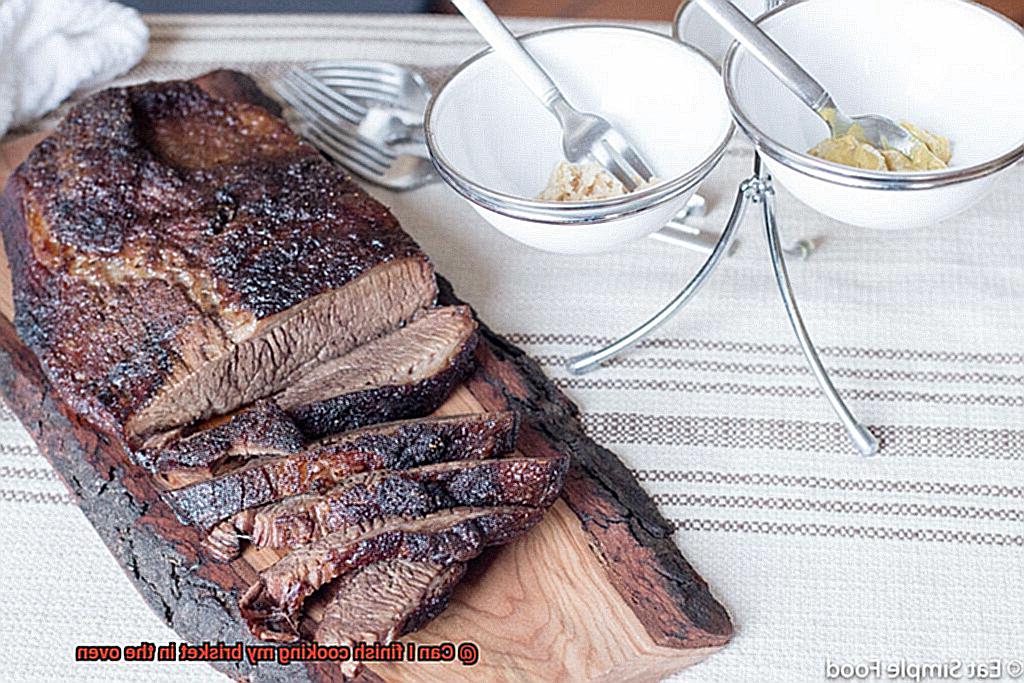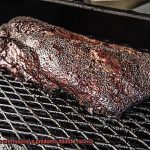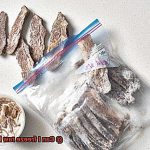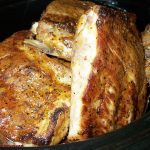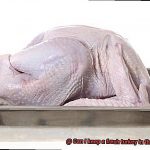Ever had a moment when your beloved brisket just didn’t turn out as juicy and tender as you hoped? Don’t worry – it happens to the best of us. But today, we’re about to let you in on a little secret that will take your brisket game to new heights. Brace yourself, because we’re diving headfirst into the world of oven-finished briskets.
Imagine this: a beautifully seasoned brisket, already infused with smoky goodness from hours on the grill or in the smoker. It’s now time for that final touch of perfection. And guess what? You can achieve it right within the cozy confines of your oven. Whether you’re short on time, battling unpredictable weather, or simply curious about an alternative approach, the oven is here to save your culinary masterpiece.
Get ready as we uncover the secrets of finishing your brisket in the oven. We’ll walk you through everything – from nailing that perfect internal temperature to achieving that heavenly bark that makes every bite unforgettable. Prepare to leave your guests spellbound with your oven-finished culinary prowess.
In this comprehensive guide, we’ll share our tried-and-true tips, tricks, and best practices for delivering a perfectly cooked brisket straight from your oven. Get ready to unleash mouthwatering aromas and flavors that will delight your taste buds while turning you into the resident pitmaster among friends and family.
So get ready for a mouthwatering mission as we venture into the world of oven-finished briskets. Together, we’ll refine your skills and forever change how you approach this quintessential BBQ dish. Let’s fire up those ovens and embark on an unforgettable journey towards brisket perfection.
Let’s get cooking.
Contents
Benefits of Finishing Brisket in the Oven
Brisket, a tough and flavorful cut of meat, is often cooked low and slow to achieve tenderness. While grilling or smoking are popular methods for cooking brisket, finishing it in the oven offers several benefits that guarantee consistent and mouthwatering results. In this article, we will explore the advantages of using the oven to finish your brisket, providing you with a reliable and convenient cooking technique.
Consistent and Controlled Cooking Environment:
Unlike grilling, where temperature fluctuations can occur due to external factors, the oven provides a controlled cooking environment. By setting a specific temperature, you can maintain it throughout the cooking process, resulting in even heat distribution. This eliminates any potential hot or cold spots that may occur on the grill, ensuring your brisket cooks evenly and becomes tender throughout.
Better Heat Retention:
The oven’s insulated environment allows for better heat retention compared to a grill. This is particularly important when cooking larger cuts of meat like brisket. The efficient heat retention helps lock in moisture, preventing the meat from drying out during the cooking process. The result? A succulent and juicy brisket that melts in your mouth with every bite.
Easy Monitoring and Adjustments:
Most ovens come with built-in thermometers or allow the use of external meat thermometers. This feature allows you to monitor the internal temperature of the brisket without opening the oven door. By tracking the temperature, you can achieve your desired level of doneness without constantly checking on it and potentially losing heat. This precise control ensures a perfectly cooked brisket every time, whether you prefer it medium-rare or well-done.
Time Control and Convenience:
Finishing brisket in the oven gives you more control over cooking time compared to grilling. You can set a timer and let the oven do its job while you focus on other tasks or simply relax. This convenience is especially beneficial for those who lead busy lives or want to enjoy the company of their guests without constantly tending to the grill. Plus, you don’t have to worry about flare-ups or adjusting the heat source during the cooking process.
Weather-Independent Cooking:
One of the significant advantages of finishing brisket in the oven is that it eliminates any concerns about weather conditions. Rain, wind, or extreme temperatures can all affect your grilling experience. However, with the oven, you can cook your brisket regardless of what’s happening outside. This is particularly useful for individuals living in regions with unpredictable weather patterns or those who prefer to cook indoors.
Preparing to Finish Cooking Brisket in the Oven
Look no further. In this comprehensive guide, we will walk you through the steps of finishing brisket in the oven. By employing these simple yet effective techniques, you’ll attain a tender and mouthwatering brisket that will make your taste buds dance with joy.
Step 1: Preheat your oven
Start by preheating your oven to the ideal temperature for slow-cooking brisket – typically, 250-275°F (120-135°C). This gentle and low heat will allow the meat to cook slowly, resulting in maximum tenderness and flavor.
Step 2: Rest and trim the brisket
Remove the brisket from the grill or smoker and let it rest for 10-15 minutes on a cutting board or large dish. During this resting period, the juices redistribute within the meat, ensuring a more flavorful and moist final result. After resting, carefully trim any excess fat from the brisket. While some fat adds flavor and moisture, too much can make the meat greasy.
Step 3: Season to perfection
For an extra burst of flavor, apply a seasoning rub or marinade to enhance the taste of your brisket. Ensure it is evenly spread and well-coated on all sides of the meat.
Step 4: Choose the right pan
Transfer the seasoned brisket to a roasting pan or baking dish that comfortably fits in your oven. Opt for a high-sided pan to catch drippings and prevent spills.
Step 5: Add liquid (optional)
Consider adding liquid to the pan for an extra layer of moisture. Options include beef broth, beer, or a mixture of water and Worcestershire sauce. This creates steam and keeps the meat moist during cooking.
Step 6: Cover and cook slowly
Seal the roasting pan tightly with aluminum foil or a lid if available. This traps heat and moisture, resulting in a tender and juicy brisket. Place the covered pan in the preheated oven and cook slowly for several hours, allowing approximately 1 hour and 15 minutes per pound of brisket.
Step 7: Check the internal temperature
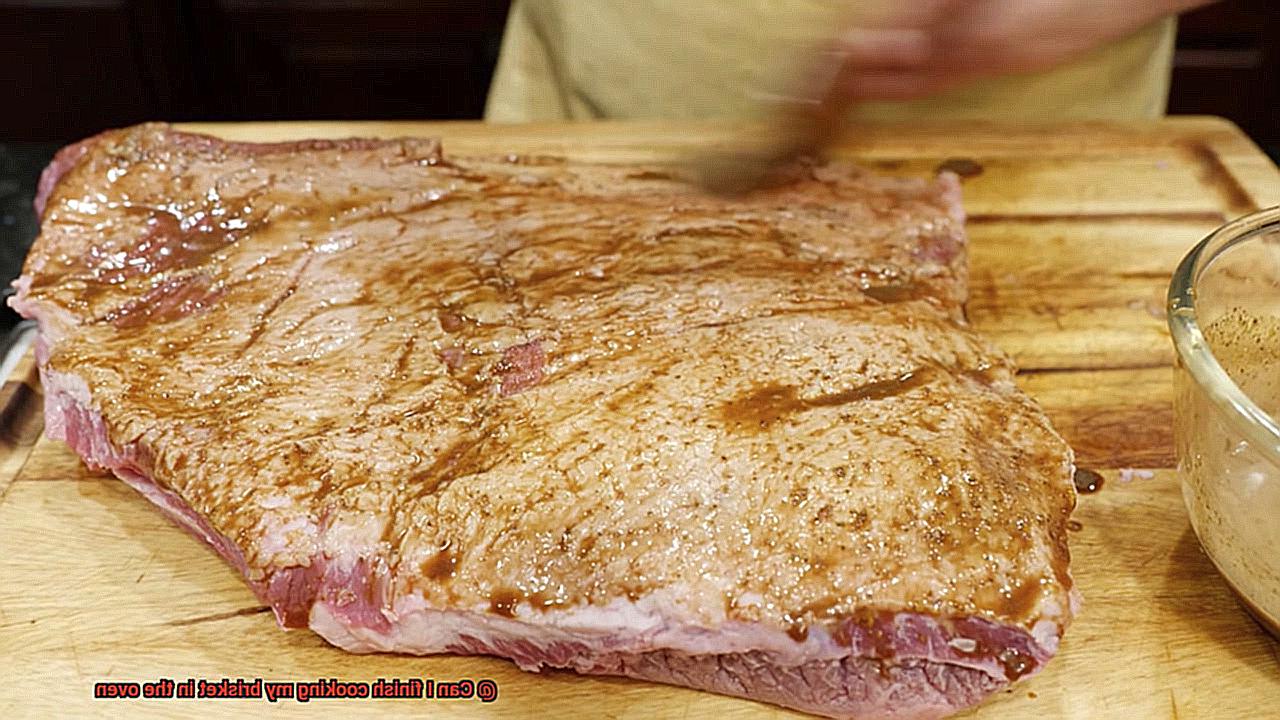
Periodically check the internal temperature of the brisket using a meat thermometer. Perfectly cooked brisket should reach around 195-205°F (90-96°C). This ensures that the collagen in the meat has broken down, resulting in a tender and melt-in-your-mouth texture.
Preheating the Oven for Finishing Brisket
Brisket, a barbecue delicacy, can reach mouthwatering perfection when finished in the oven. One essential step to achieve this culinary masterpiece is preheating the oven. Preheating not only ensures even cooking but also creates a flavorful crust that will leave your guests begging for more. In this guide, we will delve into the importance of preheating and how it contributes to the perfect brisket.
The Science Behind Even Cooking:
Preheating the oven allows for consistent temperature throughout, ensuring your brisket cooks evenly from all sides. When dealing with a large cut like brisket, even cooking is crucial to avoid tough or dry portions. By preheating the oven to around 300°F to 325°F, you establish a stable environment that gently distributes heat, resulting in tender and succulent meat.
Developing a Flavorful Crust:
Preheating plays a vital role in creating an irresistible crust on the outside of your brisket. A hot oven allows you to quickly sear the meat at an initial high temperature of around 400°F. This burst of heat caramelizes the surface, sealing in precious juices and enhancing the overall flavor profile. After achieving that beautiful crust, you can reduce the heat and continue cooking the brisket slowly at a lower and controlled temperature.
Controlled Cooking Time:
Preheating gives you better control over cooking time. Starting with a hot oven allows you to estimate the time needed to finish cooking your brisket based on its weight and desired doneness. This effective meal planning ensures your brisket is perfectly timed, eliminating guesswork.
Tips for Success:
To make the most of preheating, allow sufficient time for your oven to reach the desired temperature, typically between 10 to 30 minutes depending on efficiency. Using an oven thermometer is recommended for accuracy and consistency throughout the cooking process.
Finishing the Brisket in the Oven
The tantalizing aroma of a perfectly cooked brisket has the power to transport you to BBQ heaven. The tenderness, smoky flavor, and mouthwatering juiciness make it a favorite among meat lovers. But what if time is running out or the weather is not cooperating with your outdoor cooking plans? Fear not. Finishing your brisket in the oven is a game-changing technique that guarantees a delectable result, regardless of the circumstances. So, roll up your sleeves and embark on the journey of bringing brisket to oven glory.
Step 1: Preheat to Perfection
To achieve tender and juicy results, start by preheating your oven to a low temperature, around 225°F (107°C). This blissful symphony of low and slow cooking allows the flavors to dance and meld together in perfect harmony.
Step 2: Wrap It Up
Before placing your brisket in the oven, envelop it tightly in either aluminum foil or butcher paper. This ingenious trick locks in the precious moisture and prevents any chance of drying out during its transformation into a succulent masterpiece.
Step 3: Position for Success
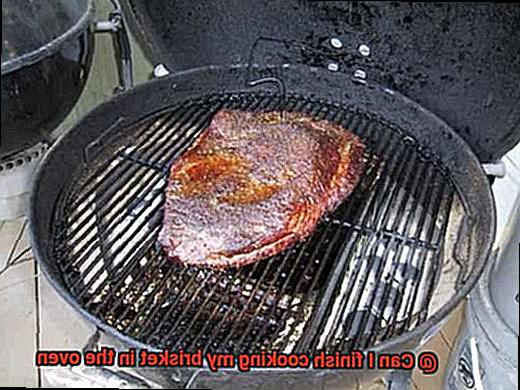
Now, place the wrapped brisket on a baking sheet or in a roasting pan, ensuring that it rests fat-side up. This strategic positioning allows the fat to gracefully render down and baste the meat as it cooks, adding an extra layer of richness and tenderness.
Step 4: Time is of the Essence
Cooking times may vary depending on factors such as size and desired tenderness. As a general rule of thumb, plan on cooking your brisket for an additional 1-2 hours per pound (0.45-0.9 kg) in the oven. Keep a watchful eye as it metamorphoses into a culinary marvel.
Step 5: Temperature Check
To ensure your brisket reaches its full potential, employ the aid of a meat thermometer to monitor its internal temperature. The ideal range for a fully cooked brisket is around 195°F (90°C). However, personal preference may sway you to adjust slightly higher or lower, depending on the desired level of succulence.
Step 6: Rest and Rejoice
Once your brisket has achieved the desired temperature, remove it from the oven and allow it to rest for at least 15-30 minutes. This crucial step grants the flavorful juices ample time to redistribute, resulting in a more tender and flavorful end product. Trust us – patience truly pays off.
Step 7: Smoky Magic (Optional)
While finishing your brisket in the oven yields spectacular results, some may miss the smoky essence that grilling or smoking imparts. If you yearn for that irresistible smokiness, consider adding liquid smoke or using wood chips in a smoker box while your brisket luxuriates in the oven.
Monitoring Internal Temperature of the Brisket
The secret to achieving a perfectly cooked brisket lies in one crucial element: monitoring the internal temperature. It’s the key to unlocking that mouthwatering tenderness and flavor that will have you and your guests coming back for seconds. Lucky for you, I’ve compiled some expert tips to help you navigate this temperature monitoring journey like a pro.
First and foremost, invest in a digital meat thermometer. Trust me, this nifty gadget will be your best friend throughout the cooking process. Accurate and easy to use, it will ensure that you get precise readings every time.
When it’s time to insert the thermometer probe into the brisket, aim for the thickest part of the meat. Gently slide it in, taking care to avoid bones or fat. We want an accurate reading of the meat’s temperature, not the surrounding components.
Remember that different parts of the brisket may cook at slightly different rates. To ensure accuracy, check multiple spots with your thermometer. This way, you’ll have a comprehensive understanding of how the entire brisket is cooking.
While monitoring regularly is important throughout the cooking process, it becomes even more critical during the final stages. This is when you’re approaching that perfect level of doneness. Don’t risk overcooking or undercooking your masterpiece – keep a close eye on that temperature.
When checking the temperature, be quick and precise. Insert and remove the thermometer probe swiftly to avoid losing too much heat from your oven or grill. Every second counts when it comes to maintaining that ideal cooking environment.
To make your cleanup a breeze, place a baking sheet or aluminum foil beneath your brisket to catch any delicious drippings that may escape during cooking. This simple step will save you from scrubbing down your oven or grill later on.
If your digital thermometer has an alarm feature, take advantage of it. Set it to go off when your brisket reaches that magic internal temperature of 195°F to 205°F. This way, you won’t have to constantly check the thermometer – it will alert you when it’s time.
Once your brisket reaches the desired temperature, resist the temptation to dig in immediately. Allow it to rest for at least 15-30 minutes before slicing and serving. This resting period allows the juices to redistribute, resulting in a more flavorful and tender brisket.
Important Considerations When Finishing a Brisket in the Oven
Prepare to take your brisket game to new heights. While grilling is the traditional method, oven-finishing can yield equally tantalizing results. In this guide, we will explore key considerations that guarantee tender, flavorful, and juicy brisket every time. So grab your apron, preheat your oven, and let’s get cooking.
The Low and Slow Rule:
For a melt-in-your-mouth texture, abide by the golden rule of low and slow cooking. Set your oven temperature between 225-250 degrees Fahrenheit. This gentle heat allows tough connective tissues to break down while infusing your brisket with mouthwatering flavors.
Preheat for Success:
Ensure even cooking by properly preheating your oven before placing the brisket inside. Allow sufficient time for the oven to reach the desired temperature, guaranteeing consistent and reliable results.
The Perfect Pan:
Choose a roasting pan with a rack or a high-sided baking dish to capture those delectable drippings. Not only does this prevent messy spills, but it also offers opportunities for basting and moisture retention.
Baste for Moisture:
To preserve moistness and succulence, regularly baste your brisket with its own juices or a flavorful marinade. This simple step imparts additional layers of flavor while preventing dryness during the cooking process.
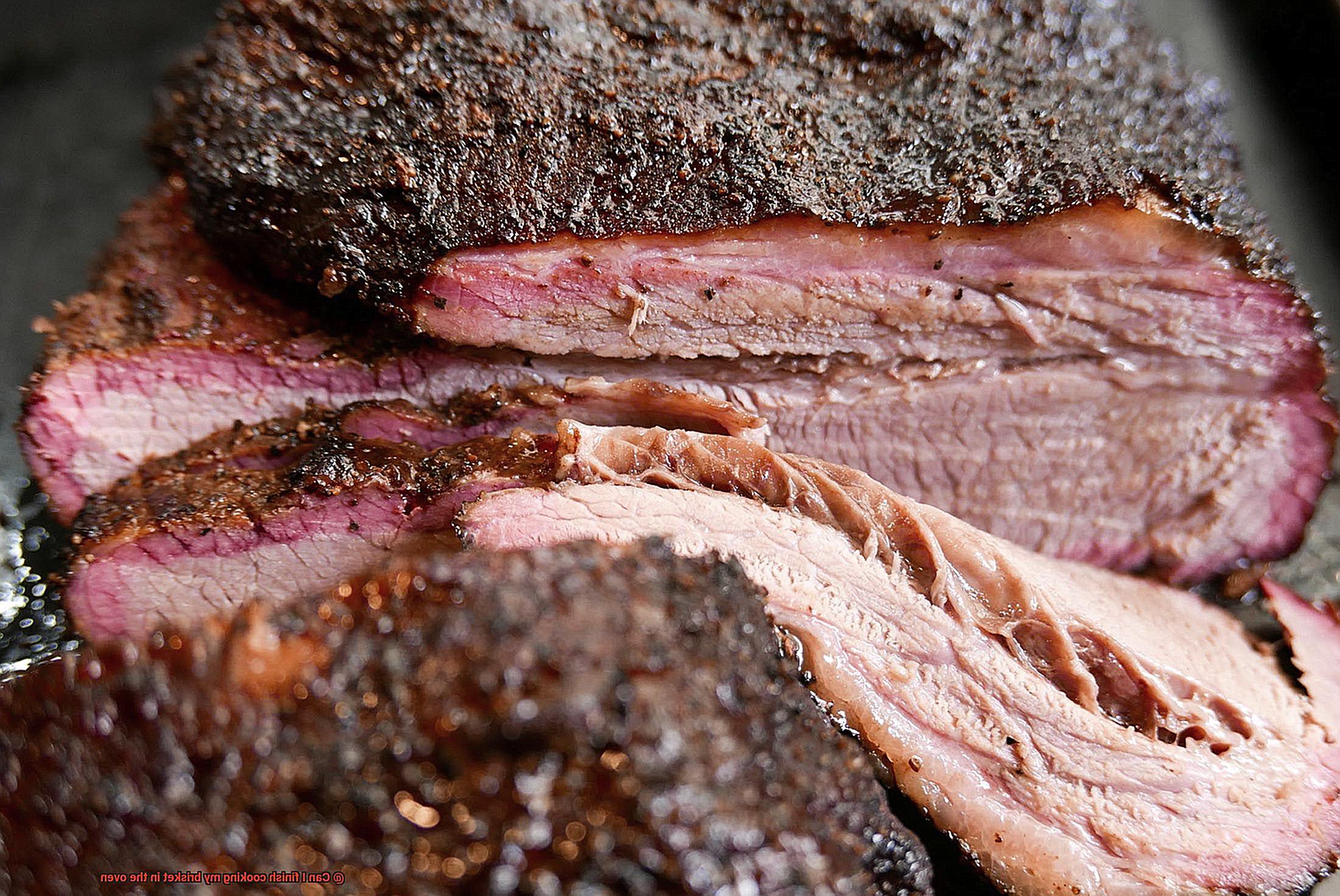
Liquid Magic:
Elevate tenderness and juiciness by adding liquid to the baking dish. Consider beef broth or beer to create steam that locks in moisture and enhances the overall flavor profile.
Temperature Check:
Invest in a reliable meat thermometer to monitor the internal temperature of your brisket. Aim for an ideal internal temperature between 195-205 degrees Fahrenheit to achieve perfection without risking overcooking or dryness.
Rest and Relax:
Patience is key to tender and juicy brisket. Allow your masterpiece to rest for at least 30 minutes before slicing. This crucial step allows the juices to redistribute throughout the meat, resulting in a more flavorful and moist final product.
Enhancing the Flavor:
Although oven-finishing lacks the smoky essence of grilling or smoking, you can still infuse your brisket with a hint of that signature taste. Consider adding wood chips or liquid smoke to the baking dish for an elevated flavor profile that will impress your guests.
Resting and Serving Finished Brisket
Resting and serving a finished brisket is an essential step in the cooking process that shouldn’t be overlooked. After hours of grilling, it’s crucial to let the meat rest before slicing and serving. This resting period allows the juices to redistribute within the meat, resulting in a more tender and flavorful final product.
To properly rest a brisket, remove it from the heat source and let it sit at room temperature for at least 30 minutes to an hour. This allows the meat to relax, and the internal temperature to even out. During this time, be cautious not to overcook it as the residual heat will continue cooking the brisket slightly.
While resting, loosely cover the brisket with foil. This helps retain heat and moisture, preventing the meat from drying out. However, be careful not to wrap it too tightly, or you’ll end up with a soggy bark – and nobody wants that.
Once rested, it’s time to slice and serve. Before cutting into the meat, identify the grain direction. Brisket has two different muscles – the flat and the point – each with its own distinct grain. Slicing against the grain is crucial for achieving tender and easy-to-chew slices.
Using a sharp carving knife or an electric knife, begin slicing against the grain on one end of the flat muscle, making each slice about ¼ inch thick. Continue slicing across the entire flat muscle before moving on to the point muscle.
Now that your perfectly sliced brisket is ready, it’s time to serve it up. Arrange the slices on a serving platter or individual plates. For added flavor, serve with barbecue sauce on the side for dipping or drizzling. You can also pair it with traditional barbecue sides like coleslaw, cornbread, baked beans, or potato salad.
If serving a large group and wanting to keep the brisket warm, place the sliced meat in a shallow baking dish and cover it with foil. Keep it in a preheated oven set to a low temperature (around 200°F) until ready to serve. Just be mindful not to leave it in the oven for too long, as you don’t want dry brisket.
W9_m0PZN2yw” >
Conclusion
Yes, you can absolutely finish cooking your brisket in the oven. It’s a fantastic way to achieve that mouthwatering tenderness and delicious flavor. The oven provides a controlled and even heat distribution, ensuring that your brisket cooks evenly throughout. Plus, it allows for easy monitoring and adjustment of the cooking temperature.
By transferring your brisket from the grill or smoker to the oven, you can continue slow-cooking it at a low temperature, allowing all those wonderful flavors to develop and meld together. The oven’s gentle heat will help break down the tough connective tissues in the meat, resulting in a melt-in-your-mouth texture that is sure to impress.
To finish cooking your brisket in the oven, simply wrap it tightly in foil or place it in a covered roasting pan. Set your oven temperature to around 225-250 degrees Fahrenheit (107-121 degrees Celsius) and let it cook for several hours until it reaches an internal temperature of around 195-205 degrees Fahrenheit (90-96 degrees Celsius). This low and slow method ensures that your brisket becomes incredibly tender and juicy.
As an added bonus, finishing your brisket in the oven allows you to free up space on your grill or smoker for other dishes or ingredients. It’s a convenient option that still delivers outstanding results.

